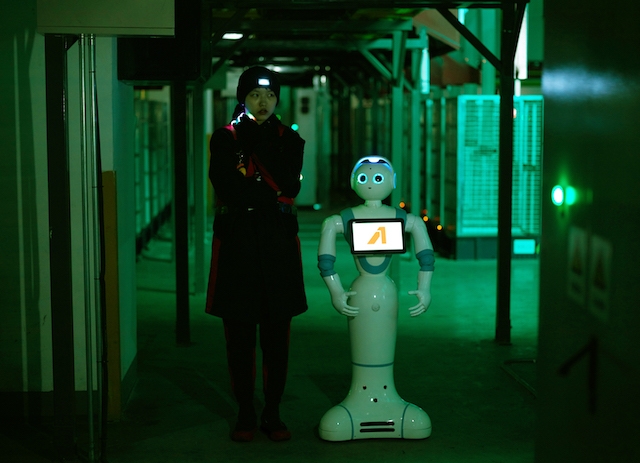Forget luxury communism. Sure, there’s not much work for humans in the fully automated warehouses depicted in Cao Fei’s video and multimedia installation Asia One (2018) – included in this survey of artists exploring the impacts of technology and globalisation on our understanding of the future – compared to the labour-intensive factory in the same artist’s Whose Utopia (2006). But instead of leisurely idyll, Asia One presents a near-future in which the regime of work has been replaced by a totalised dystopia of control, surveillance, isolation and ennui.
Incorporating choreographic sequences from the 1960s revolutionary opera On the Docks and dazzling 3D models of logistical operations, there’s plenty in Asia One to indulge fetishists of China’s socialist past or hyperdeveloped future. Past and present conditions of labour – be it Great Leap Forward-style optimism about constructing socialist modernity, or networked capitalist consumption and circulation – are the backdrop to a romance between two workers, the promise of human connection suspended between fantasy and reality. The installation features workers’ uniforms, corporate ephemera and interviews with real employees at the Chinese ecommerce giant Jingdong, suggesting lives enmeshed in exploitation, alienation and marketing ideologies.
The play of Sino-futurism and Sino-pessimism in Cao Fei’s ode to logistics anchors the five newly commissioned works in One Hand Clapping. Each considers new horizons for our technocratic-capitalist present, of which ‘China’ appears to be a pioneer. The resulting works reflect artistic strategies that navigate a host of concepts and realities of ‘China’ – often entertained as a place of alternative modernity and accelerationist fantasy, as evinced in the show’s title design, which combines classic serif type with a pixel font reminiscent of 8-bit Nintendo handles.
Hong Kong artist Wong Ping’s animated video installation Dear, can I give you a hand? (2018) tells the exploits of a sex-starved widower belonging to a surplus population of megalopolitan seniors. With the aesthetics of an early videogame and a colourful geometry that recalls the Memphis movement, the visual storytelling oscillates between the cute and the lewd, naughty and absurd, perversion and repression. The artist’s Cantonese voiceover delivers deadpan, graphic depictions of lust, male impotence and the morbidity of hypercommodified urban life. In this world, sex is stripped of reproductive function and becomes a never-consummated loop of sensory stimulation and response; death, denoting a state of nonproductivity, is relegated to the virtual sphere. In a society racing into a future already identifiable as reality, VHS tapes and prosthetic teeth – like the plastic wind-up denture toys scattered behind the screen – are rendered relics of the present.
What about objects that can only be simulated? Samson Young’s sound installation for Possible Music #1 (feat. NESS & Shane Aspergren) (2018) consists of a set of ‘impossible instruments’ – in this case, classical Western instruments blown up to a size unplayable by humans. A programmed composition travels through two rows of fake flower-adorned speakers on the floor, while conceptual drawings and hefty, 3D-printed reeds and mouthpieces in washed-out primary colours are mounted on the walls. We only know the instruments are ‘impossible’ because we’ve been informed by the wall text, creating an ambiguity between knowing and unknowing. This process is further destabilised by political ciphers that defy immediate legibility, like a military-style call schedule, and the surprise appearance of a dragon in a nearby video, breathing fire into a colossal trumpet in the colonial-era Hong Kong Stadium.
Li Yilin’s site-specific three-part installation Monad (2018) pairs two videos of staged interventions in the museum’s space – by a human body and a basketball – with a short VR, in which the viewer assumes the place of a ball set in dizzying motion by NBA player Jeremy Lin. In the first intervention, the artist ascends Frank Lloyd Wright’s spiral ramp in a slow, sideways roll. The action is unsettling to watch, punctuated as it is by the thunderous bangs of a basketball hitting the floor of the concourse having fallen through its open central space from the height of the Guggenheim’s dome.
Guangzhou-based painter Duan Jianyu’s Spring River in the Flower Moon Night 1 (2017), named after a classic Tang poem, is one of seven paintings hung salon-style facing Wong Ping’s retro-futurist urban allegory. Parodies of myth, folklore and rural life are presented in her colour-drenched mystical landscapes populated with traditional motifs like the moon, the rabbit and goddesses, as well as anthropomorphic carrots, hairy monsters and deformed humans of her own invention. The composition contains but does not reconcile these figures, which seem to belong to different times and places, fantastic yet condemned to earthly exile. Rough brushwork and unstable perspectives show an affinity with ‘bad painting’ – a faux-naïf fiction that transcends the sum of its elements by breaking down conventions of genre, style and reference. Beneath the paintings lie a bunch of picnicking carrot sculptures, a pair of mass-produced embroidered shoes (our peasant grandmother or auntie’s favourite), an AA battery and a mini sewing kit with colourful threads embedded in its rubber soles. This reenchantment of kitsch is neither atavistic nor nostalgic, but suggests that the spirituality of ‘rural’ taste is radically contemporary.
One Hand Clapping makes it evident that the ‘time lapse’ between Chinese and Western modernity, addressed by the Guggenheim’s Art and China After 1989: The Theater of the World last fall, has become moot. We can no longer talk of Chinese contemporary art catching up with the rest of the world, nor of art’s powerbrokers finally adjusting to China’s time. A question lingers: how much can art, the smartest planetary currency of our time according to Hito Steyerl, force open what Mark Fisher has called the ‘slow cancellation of the future’?
One Hand Clapping at Solomon R. Guggenheim Museum, New York, 4 May – 21 October
From the Summer 2018 issue of ArtReview Asia
